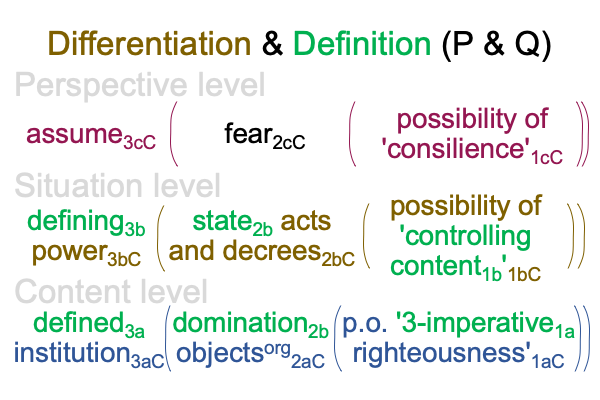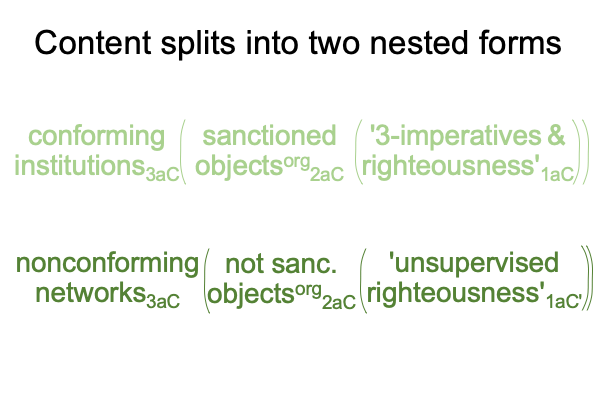Looking at Karatzogianni and Robinson’s Article (2017) “Schizorevolutions Versus Microfascisms” (Part 4 of 4)
0028 This article appears in the Journal of International Political Theory (2017, vol 13(3), 282-295). So far, my examination describes how the weird confounded diagram developed in the commentary on David Graeber and David Wengrow’s Book (2021) “The Dawn of Everything” is relevant to Karatzogianni and Robinson’s argument. This blog retells the story.
The weird diagram confounds two independent paths of articulation. The path of Graeber and Wengrow is the way of definition (P). After all, they are academics. Academics are devoted to defining their terms. The path of Razie Mah is the way of differentiation (Q). The differentiation of a nested form into the societyC, organizationB and individual in communityA tiers takes place in the chapter on presence in the masterwork, How To Define the Word “Religion”.
Here is a picture of the situation and content levels of definition (P) confounded with the same levels of the societyC tier (Q).

0029 The above diagram does not include the perspectivec level of the societyC tier (Q). Karatzogianni and Robinson open by describing the securitisation state as exploiting and promoting an atmosphere of fear. Fear is the object that brings everyone into relation2cC.
Consequently, this confounding (P and Q) is put into perspective by a demiurge2cC, an entity standing above sovereign power, and this demiurge2cC defines the state2b.

0030 This configuration produces a split in the content level of defined3a institutions2aC.

Some institutions3b’ attempt to work with the state2b. These conforming institutions3b’ bring sanctioned organizational objects2b’ into relation with the potential1b’ of the three imperatives of domination1c’ as well as the institution’s original righteousness1b. This is useful for the state2c’, which relies on conforming institutions3b’ to situate institutions3a’ that (for whatever reason) cannot or will not conform.
Conforming institutions3b’ perform microfascist activities for the state2c’, increasing the possibility of state control1c’through forcing choices, limiting and misleading information, as well as protecting reputations. These activities are built into sanctioned organizational objectives2b’ that presumably emerge from (and situate) the potential of the institution’s original righteousness1b’. According to my reading this article, Karatzogianni and Robinson do not clearly ideate this side of the splitting.
Other institutions are downgraded (often, by state interference) into networks3a’. Nonconforming networks3a’ bring unsactioned organizational objectives2a’ into relation with the potential of ‘unsupervised righteousness’1a’. Conforming institutions3b’ are ofted viewed by the anarchy level as state apparatuses3b’ whose organizational objectives2b’ are compromised by the fact they follow the rules, even when not necessary, lie and cover up1b’.
0031 How do nonconforming networks3a’ respond?
Not as the state2c’ would like them do. The state2c’ now occupies the perspective level of an interscope that expresses the path of definition. Remember, the perspective level typically comes into play on;y when there is a failure on the situation level. In other words, the perspective level is taken for granted, until something goes wrong.
Here is the interscope of securitisation2cC.

0032 Once again, what about the response of noncomforming networks3a’ on the anarchy level?
Unsupervised righteousness1a’ inspires organization objectives2a’ that appear schizophrenic (they are listening to the voices in thier heads instead of the state) or paranoid (they think that the state is the one to fear, rather than the demiurge that defines the state). Consequently, the two actors of importance in Karatzogianni and Robinson’s article belong to the state and the anarchy levels.
0033 So, what is lacking in this article?
Situation-level institutionsb’ end up being drained of their original righteousness1b’ due to their compromise with the defining power3c’. Conforming institutions3b’ lose respectability by enforcing the three imperatives that underlie the word, “domination”1b’. Conforming institutions3b’ lose respectablity by sacrificing their original righteousness1b’ in the process of enforcing the three imperatives1b’. Yet, conforming institutions3b’ maintain respectablility by being the only ones whose organizational objectives2b’ are sanctioned by state decree2c’ and therefore less likely to suffer capricious state action2c’.
0034 It makes me wonder what the word, “respectable”, really means.
The sociological and psychological dynamics of the compliant level are ripe for exploration.
Coloration tells the story.

0035 So much for the political theory aspect of Karatzogianni and Robinson’s article, what about the “international” aspect?
After all, the article appears in the Journal of International Political Theory.
Well, in the introduction and the conclusion, the authors speculate that the security state may be a response to the anarchy generated by… or may be a strategy to control the wealth and innovations produced by… or may aim to wrest control from…
… global capitalism.
Which makes me wonder, “Could global capitalism be a demiurge, just like securitisation?”
If so, then Graeber and Wengrow’s weird confounding diagram is relevant.
And, the prior steps should apply to the following perspective-level nested form.

0036 The rest is left as an exercise for the intrepid inquirer.
